The Aircraft Turn Coordinator Market is estimated to be valued at USD 2.6 billion in 2025 and is projected to reach USD 3.9 billion by 2035, registering a compound annual growth rate (CAGR) of 4.4% over the forecast period.
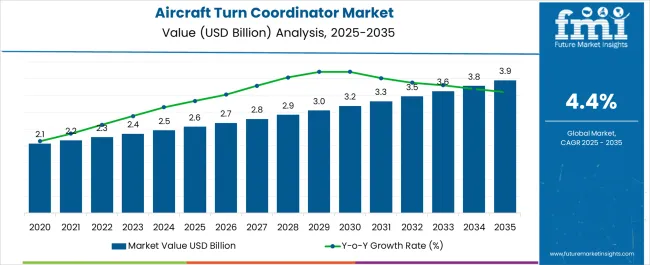
| Metric | Value |
|---|---|
| Aircraft Turn Coordinator Market Estimated Value in (2025 E) | USD 2.6 billion |
| Aircraft Turn Coordinator Market Forecast Value in (2035 F) | USD 3.9 billion |
| Forecast CAGR (2025 to 2035) | 4.4% |
The Aircraft Turn Coordinator market is experiencing steady growth, supported by the increasing demand for advanced avionics that enhance flight safety and operational efficiency. The market in 2025 is shaped by rising air traffic, continuous fleet modernization, and stricter regulatory standards that mandate reliable flight instruments. Aircraft turn coordinators are being increasingly adopted as part of integrated cockpit systems, ensuring accurate information about yaw and roll that supports safer navigation under both visual and instrument flight conditions.
The trend toward digital cockpit transformation has further expanded opportunities for software integrated turn coordinators that deliver real time data to pilots and flight control systems. Growth is being reinforced by civil aviation expansion, as airlines worldwide continue to upgrade and replace older aircraft with newer models.
The market outlook suggests that innovation in compact designs, extended lifecycle instruments, and compatibility with next generation avionics suites will drive adoption across both civil and defense aviation With ongoing investments in global air infrastructure, demand for dependable flight instruments remains firmly positioned for long term growth.
The aircraft turn coordinator market is segmented by end-user, sales channel, and geographic regions. By end-user, aircraft turn coordinator market is divided into Civil Aircraft, Narrow-Body, Wide-Body, Regional, and Military Aircraft. In terms of sales channel, aircraft turn coordinator market is classified into OEM and Aftermarket. Regionally, the aircraft turn coordinator industry is classified into North America, Latin America, Western Europe, Eastern Europe, Balkan & Baltic Countries, Russia & Belarus, Central Asia, East Asia, South Asia & Pacific, and the Middle East & Africa.
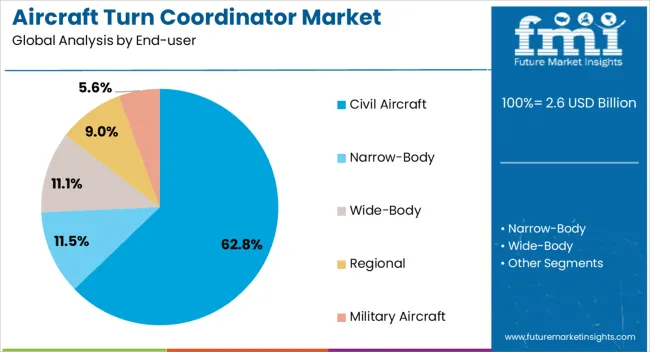
The Civil Aircraft segment is anticipated to hold 62.80% of the Aircraft Turn Coordinator market revenue in 2025, positioning it as the dominant end user. This leadership is being attributed to the continuous growth in global passenger traffic, which has created a strong need for modernized civil fleets equipped with reliable cockpit instruments. The emphasis on passenger safety and compliance with strict aviation standards has driven the installation of advanced turn coordinators across commercial and private aircraft.
Civil operators are increasingly investing in avionics upgrades to improve operational efficiency and extend fleet life cycles, which has reinforced demand for these instruments. The ability of turn coordinators to provide critical data for pilot awareness, especially during adverse weather conditions and low visibility operations, has made them an indispensable component in civil aviation.
Additionally, the global expansion of regional carriers and the rising number of light aircraft for business and recreational use have further contributed to the segment’s growth As civil aviation continues to expand worldwide, the dominance of this segment is expected to remain strong, supported by ongoing aircraft deliveries and modernization programs.
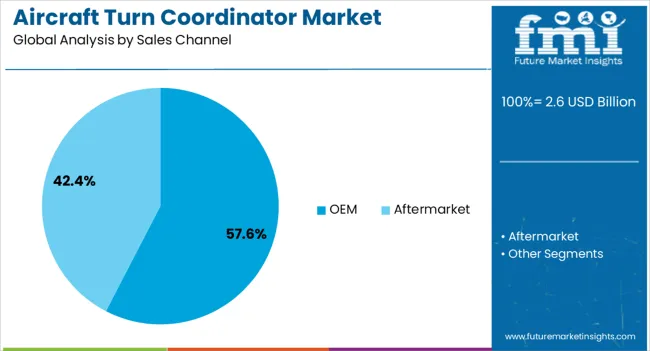
The OEM segment is expected to capture 57.60% of the Aircraft Turn Coordinator market revenue in 2025, making it the leading sales channel. This strong share is being driven by the growing demand for factory fitted avionics as aircraft manufacturers focus on integrating advanced systems during production. OEM installation ensures higher reliability and seamless integration with broader cockpit instrumentation, which has become a key requirement for both civil and defense aviation buyers.
The rising number of new aircraft deliveries, driven by global fleet expansion and replacement of aging aircraft, has significantly contributed to the dominance of OEM sales. Airlines and operators increasingly prefer aircraft delivered with pre installed and certified avionics systems, minimizing downtime and ensuring compliance with aviation authorities from the outset. Furthermore, OEMs are investing in collaborative programs with avionics suppliers to design next generation cockpit systems that include highly accurate and software enabled turn coordinators.
This approach has secured a long term pipeline of demand at the production stage As aircraft manufacturing continues to scale to meet rising air travel needs, OEMs are expected to maintain their leading share in the market.
Aircraft turn coordinator is an advancement of turn and slip indicator, which displays the rate of turn along with roll information, as well as quality and coordination of the turn. Aircraft turn coordinator’s gimbal is pitched up 30 - 35 degrees from the transverse axis allowing it to respond to roll as well as yaw. Aircraft turn coordinator is a part of Electronic Flight Instrument System (EFIS) and is a part of six basic instruments in an aircraft a pilot needs for legal instrument flying. Aircraft turn coordinator is a performance instrument and generally comes in handy when altitude indicator fails.
The aircraft turn coordinator enhances the aircraft control and achieve a non-slip turn. Aircraft turn coordinators are more prevalent in commercial and training aircrafts. Growing demand for high performance aircraft is estimated to fuel the demand for advanced indicators such as aircraft turn coordinators for improved reliability and convenience. This in turn is expected to contribute towards the growth of the global aircraft turn coordinator market.
Air transport industry is growing and is evolving to manage the increasing demand for passenger travel, which is set to drive the growth of aircraft fleet size. This in turn is expected to be the prime factor driving the growth of global aircraft turn coordinators market.
Global economy has witnessed healthy growth over the recent past and is expected to grow at a moderate pace for the forecast period. Rapid population growth coupled with increasing disposable income of middle class is expected to contribute towards the growth of aircraft industry in turn propelling the growth of aircraft turn coordinators market. Moreover, mid-sized aircrafts (100 - 200 seats segments) is expected to unlock new horizon for the aircraft turn coordinator market participants, particularly in the developing markets such as China, South Africa and South Asia.
The replacement of aging aircrafts is expected to boost the demand for aircraft turn coordinators. The need for replacement of aging fleet of aircrafts is due to the need for enhancing operating efficiency & the revenue requirements of the operating airlines.
One of the major challenge faced by the aircraft turn coordinator market manufacturers is the sophistical design of the indicator and need for reliable instrument with high level of accuracy. Hence the manufacturers are emphasizing on developing and offering durable, light weight, high performance and reliable aircraft turn coordinators at lower cost to get competitive advantages.
With the growing aircraft fleet size across the globe the aircraft turn coordinator market is expected to experience positive growth in the years to come. North America is expected to contribute significantly towards the growth of global aircraft turn coordinator market owing to presence of a large number manufacturing base.
Asia Pacific is expected to be an opportunistic region for the growth of aircraft turn coordinator market. The growth of the aircraft turn coordinator market in the region is expected to lead by rapid increase in passengers, growth in wealth and size of the middle class and liberalization of markets.
Over the recent past, Asia Pacific has emerged as a prominent region in aviation industry and is expected to remain robust throughout the forecast period. According to the International Air Transport Association, the Asia Pacific passenger traffic rose by 8.3% in 2025. Which is more than the average growth of the last five years, i.e., 6.9%. This growth in passenger traffic is estimated to drive the market of aircraft turn coordinator market during the forecast period
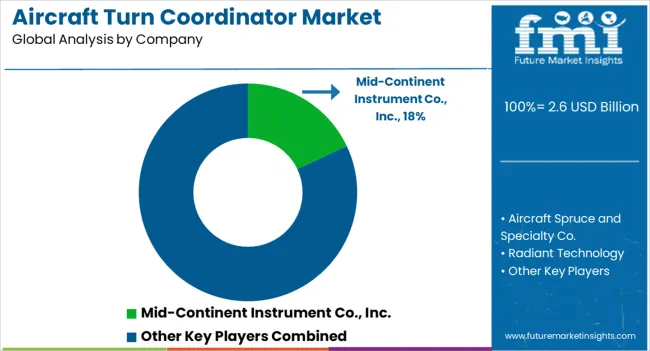
Examples of some of the market participants identified across the value chain of the global aircraft turn coordinator Market includes:
The research report presents a comprehensive assessment of the aircraft turn coordinator market and contains thoughtful insights, facts, historical data, and statistically supported and industry-validated market data. The aircraft turn coordinator market report also contains projections using a suitable set of assumptions and methodologies. The aircraft turn coordinator market research report provides analysis and information according to aircraft turn coordinator market segments such as geographies, application, and industry.
The report is a compilation of first-hand information, qualitative and quantitative assessment by industry analysts, inputs from industry experts and industry participants across the value chain. The report provides in-depth analysis of parent market trends, macro-economic indicators and governing factors along with market attractiveness as per segments. The report also maps the qualitative impact of various market factors on market segments and geographies.
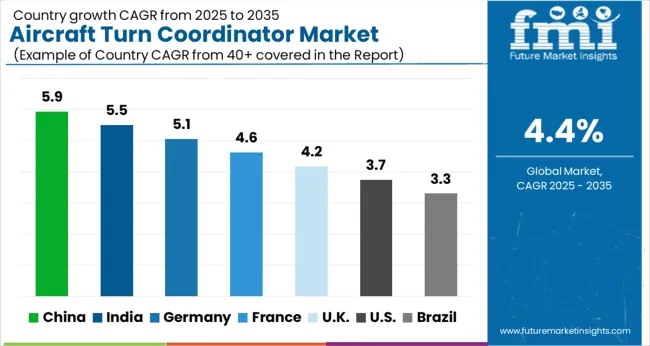
| Country | CAGR |
|---|---|
| China | 5.9% |
| India | 5.5% |
| Germany | 5.1% |
| France | 4.6% |
| UK | 4.2% |
| USA | 3.7% |
| Brazil | 3.3% |
The Aircraft Turn Coordinator Market is expected to register a CAGR of 4.4% during the forecast period, exhibiting varied country level momentum. China leads with the highest CAGR of 5.9%, followed by India at 5.5%. Developed markets such as Germany, France, and the UK continue to expand steadily, while the USA is likely to grow at consistent rates. Brazil posts the lowest CAGR at 3.3%, yet still underscores a broadly positive trajectory for the global Aircraft Turn Coordinator Market. In 2024, Germany held a dominant revenue in the Western Europe market and is expected to grow with a CAGR of 5.1%. The USA Aircraft Turn Coordinator Market is estimated to be valued at USD 930.4 million in 2025 and is anticipated to reach a valuation of USD 1.3 billion by 2035. Sales are projected to rise at a CAGR of 3.7% over the forecast period between 2025 and 2035. While Japan and South Korea markets are estimated to be valued at USD 134.7 million and USD 76.5 million respectively in 2025.
| Item | Value |
|---|---|
| Quantitative Units | USD 2.6 Billion |
| End-user | Civil Aircraft, Narrow-Body, Wide-Body, Regional, and Military Aircraft |
| Sales Channel | OEM and Aftermarket |
| Regions Covered | North America, Europe, Asia-Pacific, Latin America, Middle East & Africa |
| Country Covered | United States, Canada, Germany, France, United Kingdom, China, Japan, India, Brazil, South Africa |
| Key Companies Profiled | Mid-Continent Instrument Co., Inc., Aircraft Spruce and Specialty Co., Radiant Technology, Baocheng Group Co., Ltd., Chief Aircraft Inc., KELLY MANUFACTURING CO., Rieker Inc., and Gulf Coast Avionics |
The global aircraft turn coordinator market is estimated to be valued at USD 2.6 billion in 2025.
The market size for the aircraft turn coordinator market is projected to reach USD 3.9 billion by 2035.
The aircraft turn coordinator market is expected to grow at a 4.4% CAGR between 2025 and 2035.
The key product types in aircraft turn coordinator market are civil aircraft, narrow-body, wide-body, regional and military aircraft.
In terms of sales channel, oem segment to command 57.6% share in the aircraft turn coordinator market in 2025.






Full Research Suite comprises of:
Market outlook & trends analysis
Interviews & case studies
Strategic recommendations
Vendor profiles & capabilities analysis
5-year forecasts
8 regions and 60+ country-level data splits
Market segment data splits
12 months of continuous data updates
DELIVERED AS:
PDF EXCEL ONLINE
Aircraft Cooling Turbines Market Size and Share Forecast Outlook 2025 to 2035
Aircraft Smoke Detection and Fire Extinguishing System Market Size and Share Forecast Outlook 2025 to 2035
Aircraft Hose Fittings Market Size and Share Forecast Outlook 2025 to 2035
Aircraft Cabin Interior Market Size and Share Forecast Outlook 2025 to 2035
Aircraft Galley Systems Market Size and Share Forecast Outlook 2025 to 2035
Aircraft Interior Lighting Market Size and Share Forecast Outlook 2025 to 2035
Aircraft Battery Market Size and Share Forecast Outlook 2025 to 2035
Aircraft Floor Panels Market Size and Share Forecast Outlook 2025 to 2035
Aircraft Fuel Systems Market Size and Share Forecast Outlook 2025 to 2035
Aircraft Lubricant Market Size and Share Forecast Outlook 2025 to 2035
Aircraft Seat Market Size and Share Forecast Outlook 2025 to 2035
Aircraft Ground Support Equipment Market Size and Share Forecast Outlook 2025 to 2035
Aircraft Maintenance, Repair and Overhaul Market Size and Share Forecast Outlook 2025 to 2035
Aircraft Actuators Market Size and Share Forecast Outlook 2025 to 2035
Aircraft Elevator Market Size and Share Forecast Outlook 2025 to 2035
Aircraft Weapons Market Size and Share Forecast Outlook 2025 to 2035
Aircraft Lighting Market Size and Share Forecast Outlook 2025 to 2035
Aircraft Micro Turbine Engines Market Size and Share Forecast Outlook 2025 to 2035
Aircraft De-icing Market Size and Share Forecast Outlook 2025 to 2035
Aircraft Window Frame Market Size and Share Forecast Outlook 2025 to 2035

Thank you!
You will receive an email from our Business Development Manager. Please be sure to check your SPAM/JUNK folder too.
Chat With
MaRIA